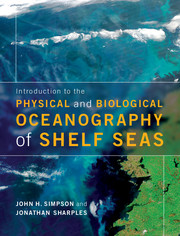Book contents
- Frontmatter
- Contents
- Preface
- Acknowledgements
- Guide to the book and how to make the best use of it
- Symbols
- 1 Introduction to the shelf seas
- 2 Physical forcing of the shelf seas: what drives the motion of ocean?
- 3 Response to forcing: the governing equations and some basic solutions
- 4 Waves, turbulent motions and mixing
- 5 Life in the shelf seas
- 6 Seasonal stratification and the spring bloom
- 7 Interior mixing and phytoplankton survival in stratified environments
- 8 Tidal mixing fronts: their location, dynamics and biological significance
- 9 Regions of freshwater influence (ROFIs)
- 10 The shelf edge system
- 11 Future challenges in shelf seas
- Glossary
- Answers to chapter problems
- References
- Index
- Plate section
- References
11 - Future challenges in shelf seas
Published online by Cambridge University Press: 05 June 2012
- Frontmatter
- Contents
- Preface
- Acknowledgements
- Guide to the book and how to make the best use of it
- Symbols
- 1 Introduction to the shelf seas
- 2 Physical forcing of the shelf seas: what drives the motion of ocean?
- 3 Response to forcing: the governing equations and some basic solutions
- 4 Waves, turbulent motions and mixing
- 5 Life in the shelf seas
- 6 Seasonal stratification and the spring bloom
- 7 Interior mixing and phytoplankton survival in stratified environments
- 8 Tidal mixing fronts: their location, dynamics and biological significance
- 9 Regions of freshwater influence (ROFIs)
- 10 The shelf edge system
- 11 Future challenges in shelf seas
- Glossary
- Answers to chapter problems
- References
- Index
- Plate section
- References
Summary
In this final chapter we shall try to provide a perspective of the science of shelf seas and an indication of some of the important challenges which remain. In looking to the future of the subject, we shall highlight the need to move from temperate latitude shelf seas, which have been the focus of most research to date, into the shelf seas of the Arctic and the tropics. In both these areas, the suite of physical processes controlling the shelf sea environment and its biogeochemistry is substantially different from that operating in temperate latitudes. As well as looking at the prospects for future research in these areas, we shall also consider new ideas on the role of the shelf seas in the global ocean system and their putative influence on climate change since the last ice age. But first, we shall try to identify the big questions which remain in relation to the scientific understanding of the mid latitude shelf seas.
Remaining puzzles in the temperate shelf seas
As we have seen in previous chapters, the dominant physical processes controlling the environment of the shelf seas in temperate regions have been identified. The different shelf sea regimes have been defined in terms of the particular processes which dominate them, and the interaction of these processes has, in several cases, been simulated at least to first order in numerical models.
- Type
- Chapter
- Information
- Publisher: Cambridge University PressPrint publication year: 2012



